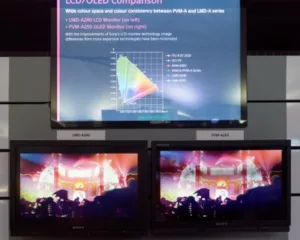Sony held its usual press event as the first of the show itself on its booth. I remember when the firm switched from projection to LCD as the main display for the event, but this year it used the Sony Crystal LED display. This mostly looked really great, but in some of the early videos, there was some clear (and disturbing) motion judder on panning. Later content showed that the judder must have been in the content – not in the display.
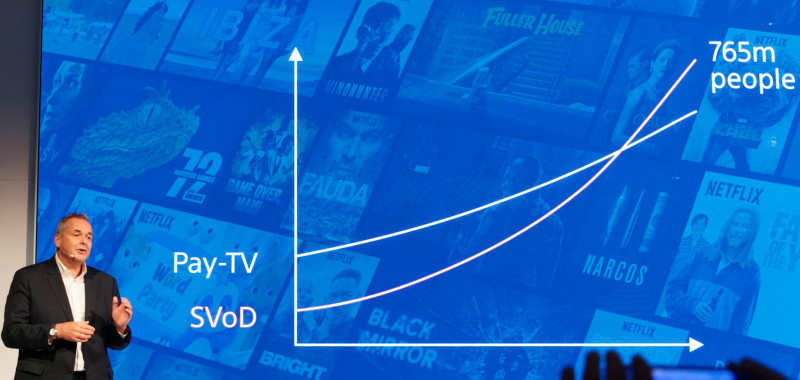 VOD Goes Past Pay TV this year. Image:Meko
VOD Goes Past Pay TV this year. Image:Meko
Adam Fry is a VP at Sony Europe and he started by pointing out that streaming a big challenge for broadcasters and we’ve reached a key point – revenues for SVOD go past traditional pay TV this year.
Fry said that 20% of content shown using Netflix is on mobile devices and 20% to 25% is being delivered via mobile networks. On that basis, 5G is likely to be disruptive.
There is good demand for content to feed traditional and OTT TV channels and high quality is really essential. Fry said that UltraHD content creation is now “standard” (although others at the show told us that they don’t see that). 60% of TV sets sold this year will ship with HDR and 80 million will be sold with the feature this year.
To help the shift to UltraHD Sony Professional will have a new service. Customers can hand back FullHD cameras to get ‘generous’ allowances for UHD upgrades. The HD cameras will be re-furbished in Sony’s Pencoed plant and re-sold with a new warranty.
IP is a big deal in content creation and SIC has built a new IP-based production facility in Lisbon (more later). Cloud services are developing with new revenue streams and allowing content owners to sell directly to consumers. For example, the NHRA (National Hot Rod Association) in the US is the organiser of drag racing and has developed a wide range of different content that users can subscribe to.
Capturing the right content at the right quality is critical and cost Sony will continue to innovate for content creators, Fry said.
There are five core areas for Sony Professional:
- Live Production
- News Production
- Cinematography
- Content Creation and
- Intelligent Media Services
For Sony Professional, products and services are getting closer in balance and services now represent one third of the company’s revenues.
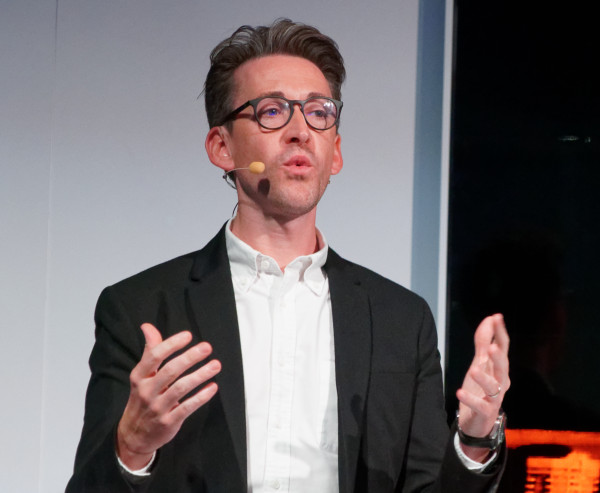 Stuart Almond highlighted Intelligent Media Services – Image:Meko
Stuart Almond highlighted Intelligent Media Services – Image:Meko
Stuart Almond is head of Marketing and Communictions and he said that there are no new forecasts this year, but rapid acceleration in the take up of services. Companies have a need for more integration and more careful investment to avoid items becoming redundant. Faster and more flexible implementation is needed.
“Intelligent Media Services” are important for the future and Sony can produce and manage content via the cloud. Almond said that broadcaster, Turner, had found that moving to the cloud had reduced edit times by 70% in its first year. Having captured material going from integrated cameras to content can save up to seven days in post production. AI is also developing as an important technology in the cloud.
Red Bull Suisse created a cloud-based production on winter sports that was done in an alpine area of Switzerland where there was very little infrastructure. The BBC has been using cloud services to reduce content administration time by 50%. The company has virtual production services starting from just €300 so it is accessible for corporates and others as well as professional content companies.
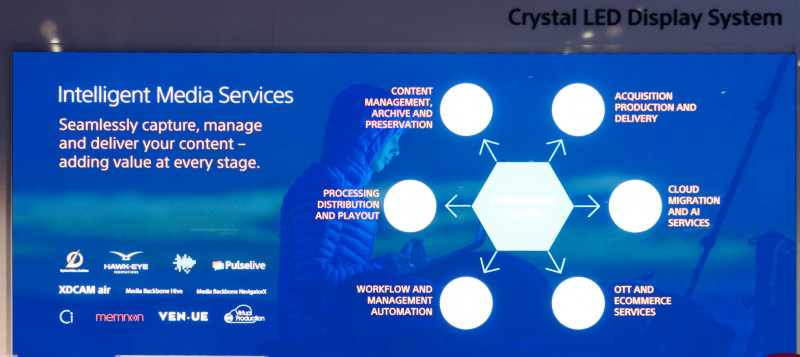 These are the areas that Sony is positioning its services. Image:Meko
These are the areas that Sony is positioning its services. Image:Meko
Live event streaming has changed and at the IBC event, the whole production system, Almond said, was just six 4G equipped cameras and a single notebook using Wi-fi to connect to the cloud and control production and the stream. (No cables, no racks of equipment – that’s quite a change).
Almond said that it is a real game changer – and we agree! (we have a Display Daily article planned to dig further into this topic)
News production needs more speed and flexibility all the time and more and more content is coming directly from the field using Sony’s XDCam Air, using Wi-fi and/or LTE to send content direct to the cloud. Cameras can connect to Sony’s Media backbone, Hive. Sony can also support remote control from newsroom to cameras in the field.
Companies including the Dutch RTV Oost and SRG SSR have produced extended coverage of long events coverage using Hive. Vatican TV and SIC Portugal are also going to Hive. “First and fast” is critical in news operations and Hive can help with this.
Next to speak was Norbert Paquet, Head of Product Management at Sony. He started by saying that there are many changes in the TV business, but it remains true that content is king and that content creation is the most valuable part of the ecosystem. In the processes of capture, edit and finish there are new challenges in 4K, 8K, HDR and in high frame rate. These are challenging the boundaries of the technology.
Paquet said that the new cameras that were shown at NAB are now available. The new 4K camcorders have more life-like colour with better skin tones and professional audio features.
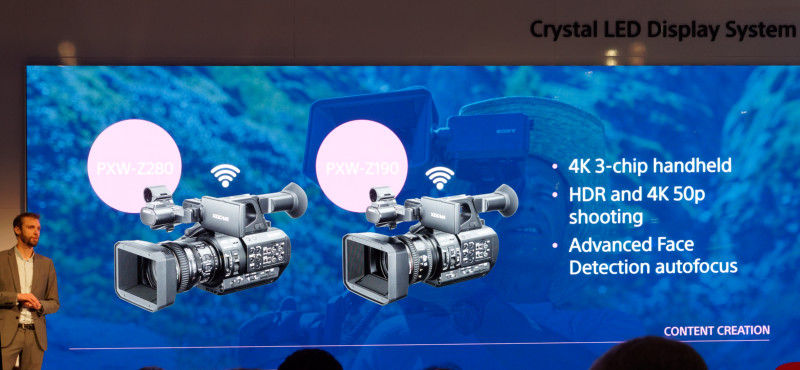 These two cameras were shown at NAB and are now available. Image:MekoTurning to cinematography, Sony has been working with film makers for three decades. The Venice camera was launched one year ago, supports full frame capture and has been very successful, Paquet said. The director, James Cameron, then endorsed the products (on video) and said that he is making Avatar 2 and 3 with the Venice camera which, he said, produces the “most astonishing image I have ever seen”. He said that Sony had heard his requirements for capture and time lapse. A number of features were added to meet the needs of film makers – this was a very positive endorsement. Netflix has approved the camera for content creation.
These two cameras were shown at NAB and are now available. Image:MekoTurning to cinematography, Sony has been working with film makers for three decades. The Venice camera was launched one year ago, supports full frame capture and has been very successful, Paquet said. The director, James Cameron, then endorsed the products (on video) and said that he is making Avatar 2 and 3 with the Venice camera which, he said, produces the “most astonishing image I have ever seen”. He said that Sony had heard his requirements for capture and time lapse. A number of features were added to meet the needs of film makers – this was a very positive endorsement. Netflix has approved the camera for content creation.
Venice will get an upgrade and a new extension system from Feb 2019 – the sensor block can be detached from body by up to 5.5 m which will make some production situations much easier. Higher resolutions have been added for even higher quality – and there are new remotes.
In live production, Sony has seen that the demand for live content is getting stronger. Sony managed the content and capture for the 2018 FIFA World Cup in Russia which was captured in FullHD and UltraHD at 64 matches and producing 2,500 hours of live coverage.
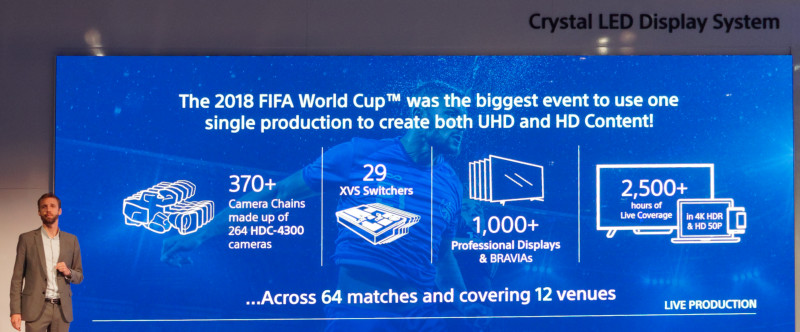 The statistics of Sony’s World Cup production project were impressive. Image:Meko
The statistics of Sony’s World Cup production project were impressive. Image:Meko
As well as the ‘standard’ video feeds, the company also created content for the Playstation VR and the company said that it had 43,000 VR users at one point. The company also helped with the games by supplying its Hawk Eye system for goal line monitoring and the VAR video review systems used to check refereeing decisions. The company had 300 staff at the event.
Still on the sporting events topic, Sony worked with the EBU and others to make the firstend to end 100Hz HDR UltraHD production at the Euro athletics championship in Berlin. The test used current market production equipment throughout.
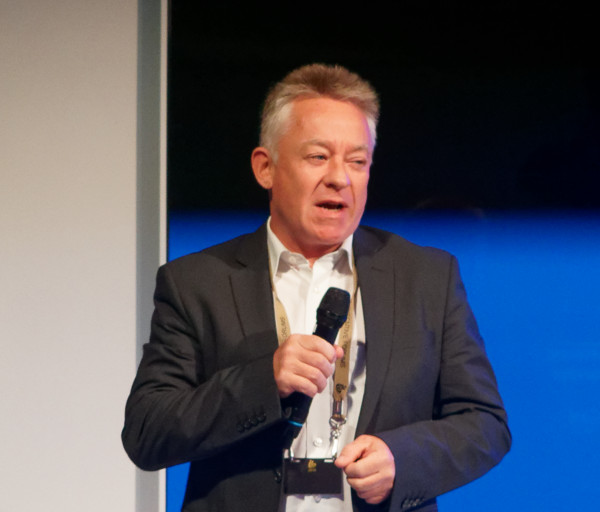 Hans Hoffmann showed some stunning 4K HDR HFR content. Image:Meko
Hans Hoffmann showed some stunning 4K HDR HFR content. Image:Meko
Hans Hoffmann of the EBU came and said that the aim was a ‘proof of concept’. Five EBU members were involved and 19 technical partners as the production also included next generation audio – it was one of the biggest EBU trials ever. He then showed video of the content.
The earlier judder problem seen on the Crystal LED disappeared and the content looked great with (from my notes at the time) “fantastic panning even of the crowd”. My notes also said that watching in this quality was “better than being there”, because in the stadium you could not get so close to the action. The footage showed the challenges of maintaining the camera focus even at 4K. (8K is going to be a huge challenge!). All in all, the combination of the great video with the Crystal LED display made a stunning demo and, I reckon, the best video I have ever seen.
HDR, HFR and UltraHD were all supported but the production showed that you need a much more flexible architecture. IPLive was used and Sony is working on products based on standards.
Jose Lopes is Manager for Technologies and Operations at SIC TV in Portugal. The company tries to be innovative in technologies and it was a pioneer of digital in news and entertainment. Its parent company, Impressa Media, decided to move to a single building so the company had to move its TV production. Lopes said that a big challenge is also a big opportunity. There were issues of budget and finance as well as many technical choices.
SIC wanted flexibility in the new facility so the company chose an IP-based architecture. Sony was closely involved in the project with a contribution from high end consulting to the supply of equipment. SIC decided to use Sony’s Hive for news where there is much fierce competiton, Lopes said.
Sony said that there would be more announcements about IP architecture adoption and more information from customer feedback.
Capturing and Grading
Hiroshi Kiriyama, VP of Sony Professional, Japan, then came on to talk about some new products.
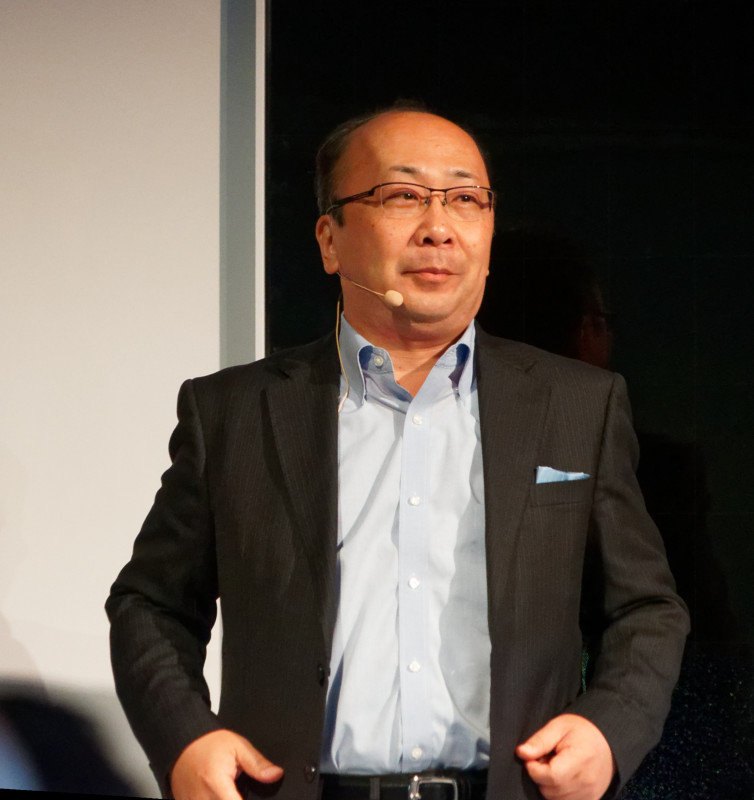
There is a new top of the range grading monitor, the BVM-HX310. HDR is becoming more important both in capture and for grading images. The new 31″ monitor can support 1000 cd/m² full screen white with 1,000,000 contrast and supporting full ‘colour volume’.
 Kiriyama highlighted the colour volume at higher intensity of the new BVM monitor.
Kiriyama highlighted the colour volume at higher intensity of the new BVM monitor.
(See our booth tour section below for more on this monitor)
The HDC-P50 is a new compact POV camera – it has a new processor and uses three of the new 2/3″ 4K CMOS image sensors with a wide spectral prism. The camera can capture the full Rec 2020 colour space. It also has a global shutter to eliminate ‘rolling shutter’ artefacts.
The HDC-3500 has the same features but is a bigger system camera and can deliver content directly by IP.
 The new monitor had to share the stage with new cameras. Image:Meko
The new monitor had to share the stage with new cameras. Image:Meko
Finally, Fry came back and summed up the announcements.
Booth Tour
We managed to meet up with staff from the broadcast monitor division to have a look at the new BVM monitor. As we had guessed from the specification that was presented at the press event, staff confirmed that the cells of the panel in the monitor are the dual layer technology from Panasonic. However, they were also very keen to point out that the backlight design is Sony’s own and is unique to the BVM-HX310. As Eizo demonstrated last year, the demonstration on the booth, side by side with the current OLED monitor, showed that there was little or no difference between the two monitors at low brightness, but as brightness went up, the LCD started to excel. The LCD also has wider colour gamut than the OLED.
The new monitor will not be available until February and pricing still has to be decided, although it is likely to be at least as expensive as the current OLED. Although Sony would be happy to discontinue the OLED version, there are plenty of people who like it, so while there is sufficient demand, it will be made available. (We didn’t hear it directly from Sony, we heard from elsewhere that panel variation is a challenge for the OLED unit and that this may be a factor in Sony preferring to make the LCD version, only. Panasonic’s LCD quality is widely regarded as very good and consistent.).
The monitor has the same processing facilities as the OLED version including the feature that allows multiple 3D LUTs to be uploaded to the whole display, but also to different parts of the screen using the PIP or PBP options. Up to four images are supported in QuadView. That means that custom LUTs can be used to show HDR (various flavours) and SDR.
On the booth, there was also a comparison of the LCD-based LMD-A240 in a side by side with the PVM-A250 to show that the colour performance of the LCD is very close to that of the more expensive OLED.
The rest of the range is unchanged since NAB.
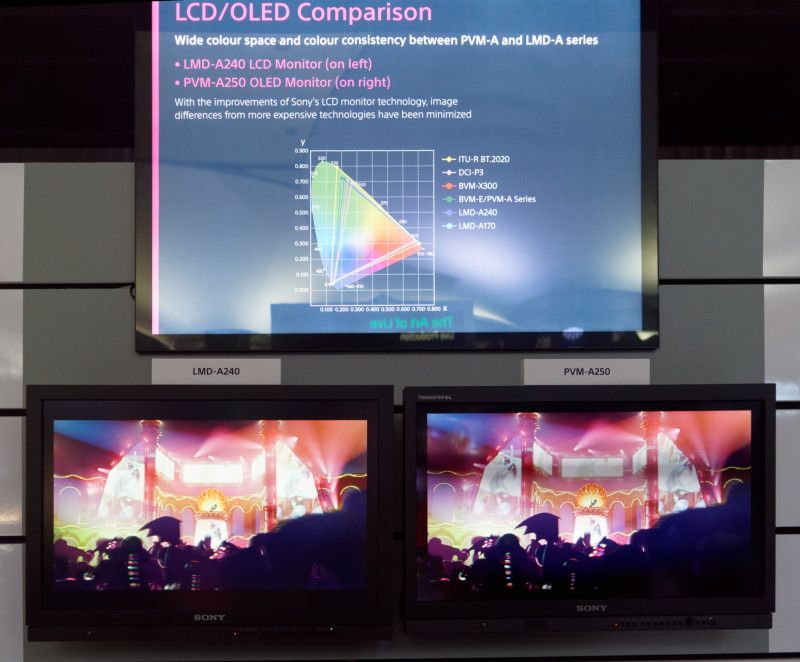 Sony has now swung behind LCD as looking better than OLED. Image:Meko
Sony has now swung behind LCD as looking better than OLED. Image:Meko

